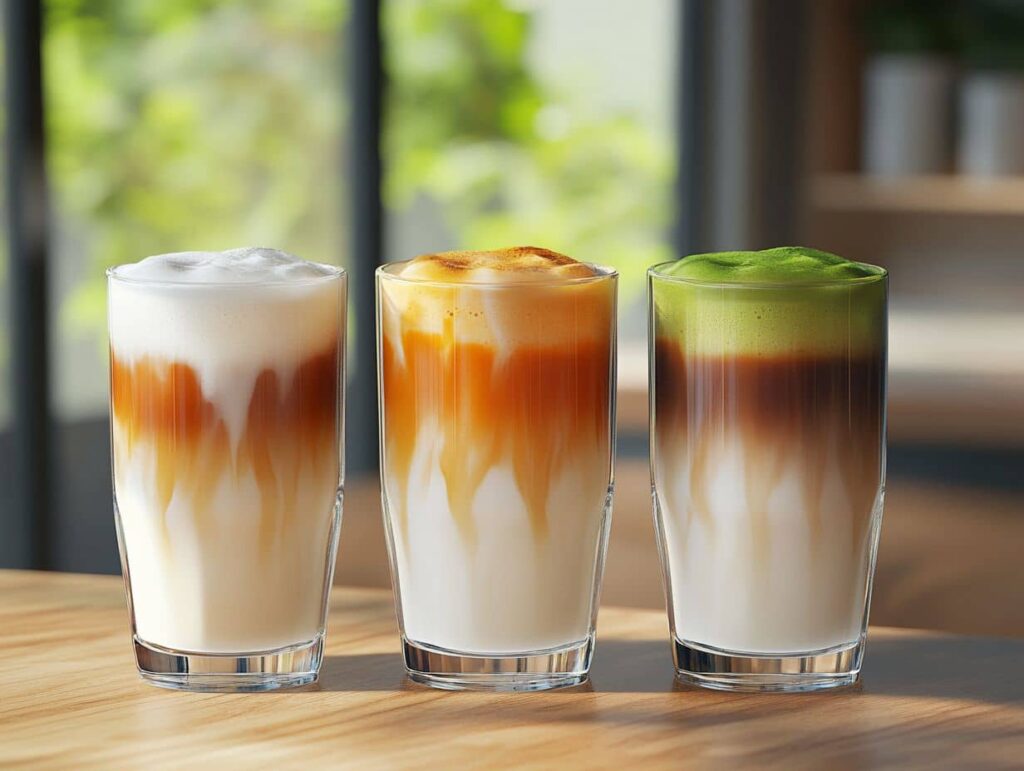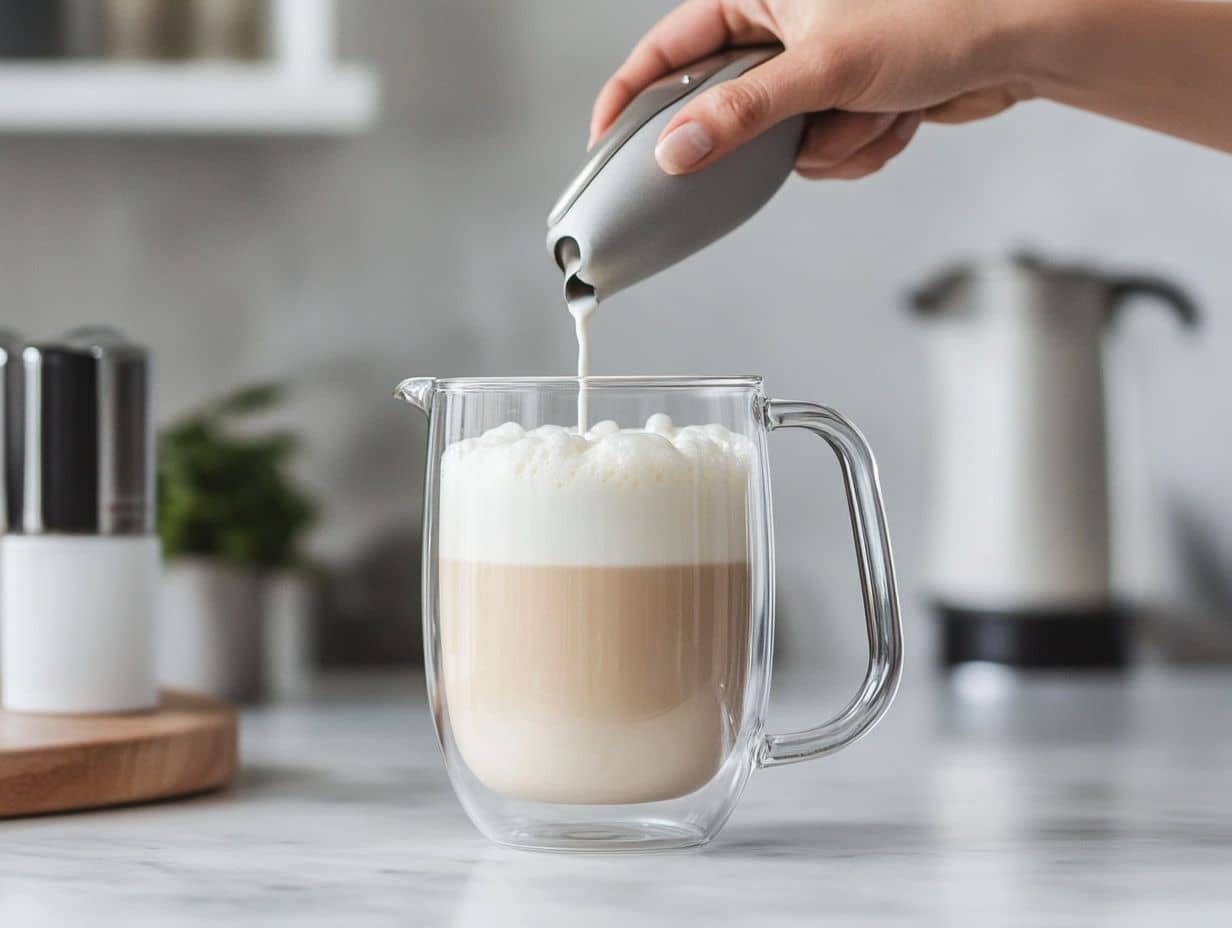What Is Cold Foam Made Of? Cold foam isn’t just a frothy topping; it’s a smooth, flavorful addition that enhances the experience of iced beverages. Whether you’re savoring a chilled cold brew or an iced latte, this creamy delight has become a favorite in the coffee world. So, what exactly is this popular topping, and what makes it unique?
Table of Contents
Exploring the Concept of Cold Foam
Where It All Began
Cold foam first gained traction in European coffee shops, quickly becoming a global favorite. Its appeal lies in its ability to mimic steamed milk’s texture while staying cool, making it a perfect pairing for iced drinks. Coffee chains like Starbucks helped popularize it, introducing a wide audience to this delightful trend. How Do They Make Cold Foam at Starbucks? showcases how this innovation reached a wider audience.
The Rise of Its Popularity
Why has this foam gained such a loyal following? Beyond its creamy flavor, it adds a touch of elegance and charm to drinks, doubling as a visual treat. It’s not just a taste enhancer; it creates a sensory experience, offering a velvety texture that doesn’t mix but floats gently atop your drink.
What Makes Cold Foam Special?
Now, let’s break down its composition:
| Ingredient | Purpose | Amount |
|---|---|---|
| Milk or Substitutes | Forms the creamy base | 1/2 cup |
| Sweeteners | Adds mild sweetness | 1-2 teaspoons |
| Optional Flavorings | Provides customization, e.g., vanilla, caramel | To taste |
Is Cold Foam Just Whipped Milk? explains why it’s more than that!
Dairy-Based Variations
Traditionally, nonfat milk is the go-to choice due to its superior frothing capability. Its high protein content ensures a light, stable foam, trapping air effectively.
Plant-Based Options
For those avoiding dairy, alternatives like oat, almond, or coconut milk work well, especially when combined with stabilizers or emulsifiers to achieve the right texture.
Common Variations
Customization is where cold foam truly shines. Why stick to plain foam when you can get creative?
Flavored Options
Add a splash of vanilla extract or a pump of caramel syrup to infuse your foam with flavor. How to Make Cold Foam offers step-by-step guidance.
Customizing Textures
Want a denser foam? Use full-fat milk. Prefer something lighter? Stick to nonfat milk. You can even experiment with blending times to adjust the fluffiness.
Fun Fact: Starbucks’ signature sweet cream cold foam combines heavy cream, 2% milk, and vanilla syrup for an ultra-rich experience.
Benefits of Cold Foam in Beverages
Why is cold foam such a hit in the coffee world? It’s not just about the taste it’s also about the experience.
Enhancing the Taste
Cold foam adds a subtle sweetness and creaminess without overpowering the drink. It’s perfect for balancing strong flavors like espresso or cold brew.
Visual and Textural Appeal
Let’s face it, cold foam makes any drink look fancy. The fluffy topping creates a layered effect, giving your beverage a gourmet vibe. Plus, it’s fun to sip through foam while tasting the underlying coffee or tea.
Is Cold Foam Healthy?
Cold foam might be indulgent, but is it good for you? The answer depends on how it’s made.
Nutritional Insights
Cold foam made with nonfat milk is relatively low in calories around 15-20 calories per serving. However, adding sweeteners or heavy cream can increase the calorie count significantly.
| Nutrient | Amount (Standard ) |
|---|---|
| Calories | 15-50 |
| Protein | 1-2g |
| Fat | 0-1g |
| Carbs | 2-6g |
Low-Calorie Options
If you’re watching your calorie intake, stick to nonfat milk or unsweetened almond milk. Use sugar substitutes or skip the sweeteners altogether for a lighter option.
Troubleshooting Cold Foam Recipes
Even the best of us can encounter challenges when making cold foam. But don’t worry most issues have simple fixes. Let’s dive into the common problems and how to solve them.
Common Mistakes
- Foam Too Runny
If your foam isn’t thick enough, it could be due to the type of milk you’re using. Nonfat milk is the gold standard because its proteins stabilize the air bubbles. Full-fat or plant-based milk can produce thinner results. - Foam Collapsing Too Quickly
Is your foam deflating before you can enjoy it? This often happens when the milk isn’t cold enough or when it’s over-frothed. Over-aerating breaks down the bubbles, making the foam unstable. - Uneven Texture
If your foam has lumps or isn’t smooth, it might be because you didn’t froth evenly. Ensure your frother or blender is clean and positioned correctly for consistent aeration.
How to Fix Foam Issues
- Problem: Foam is too thin.
- Solution: Chill your milk and tools before starting. Consider adding a dash of stabilizers, like powdered sugar or cream of tartar, for a thicker texture.
- Problem: Foam isn’t frothing at all.
- Solution: Use fresh milk, as older milk doesn’t froth well. Also, avoid milk with added oils or thickeners, which can hinder aeration.
Quick Tip: If you’re using a plant-based milk, look for varieties labeled “barista blend.” These are specially formulated for frothing.
The Science Behind Cold Foam
Understanding the science behind cold foam can help you perfect it. It’s all about the interaction between proteins, air, and temperature.
Understanding Foam Stability
Foam stability depends on the proteins in milk forming a network that traps air bubbles. Nonfat milk is ideal because its high protein-to-fat ratio creates a strong, stable structure.
Plant-based alternatives, on the other hand, rely on emulsifiers and stabilizers to mimic this effect. This is why some brands froth better than others.
The Role of Temperature
Temperature plays a critical role in foam creation. Cold temperatures help keep the foam stable, while warmer milk will collapse faster. Always start with chilled milk for the best results.
Did You Know? The temperature difference between cold foam and your iced beverage enhances the overall drinking experience by adding contrast and complexity to each sip.
Comparing Foam Types
Not all foams are created equal. Let’s explore how this frothy creation stacks up against its counterparts.
Hot Foam vs. Its Chilled Counterpart
Hot foam is crafted by steaming milk, a process that denatures its proteins and produces a dense, velvety texture. By contrast, the chilled version skips the heat entirely, relying on aeration to create its signature light and airy consistency.
| Feature | Hot Foam | Chilled Foam |
|---|---|---|
| Temperature | Warm or hot | Cold |
| Common Uses | Lattes, cappuccinos | Cold brews, iced drinks |
| Texture | Dense, creamy | Light, airy |
Comparing Tools and Techniques
Hot foam requires specialized equipment like an espresso machine or a steam wand to achieve its dense texture. In contrast, this frothy topping is far simpler to make, relying on tools such as a frother, blender, or even a humble whisk. This accessibility makes it a favorite choice for home baristas and casual coffee enthusiasts alike.
The Role in Coffee Culture
Far from being just a passing trend, this creamy addition has become a staple in modern coffee culture. Its versatility shines through as it pairs seamlessly with various beverages, from cold brews to iced teas. Baristas and coffee lovers alike appreciate its ability to elevate both the flavor and presentation of drinks, cementing its place in the coffee world.
How Baristas Use Cold Foam
Baristas love cold foam for its ability to add a luxurious touch to drinks. You’ll often find it as a topping for:
- Cold brews
- Iced lattes
- Iced teas
Some coffee shops even layer cold foam with syrups and sauces to create visually stunning drinks.
Signature Beverages with Creamy Toppings
Starbucks has popularized several drinks featuring this luscious addition, such as the Salted Caramel Cold Brew and the Pumpkin Cream Cold Brew. These beverages masterfully combine the richness of the creamy topping with bold coffee flavors, creating a harmonious balance.
Fun Fact: This frothy innovation has even inspired DIY enthusiasts to recreate popular coffee shop drinks at home, adding unique twists to classic recipes.
DIY Recipes for Creamy Toppings
Making this frothy topping at home is easier than you think, and it gives you the freedom to experiment with flavors and textures. Here’s a foolproof recipe to get you started.
Basic Cold Foam Recipe
Ingredients:
- 1/2 cup nonfat milk (or alternative of choice)
- 1-2 teaspoons sweetener (sugar, honey, or syrup)
- Optional: 1/2 teaspoon vanilla extract
Instructions:
- Chill your milk and tools.
- Add the milk and sweetener to a frother, blender, or shaker bottle.
- Froth for 30-60 seconds until thick and creamy.
- Pour over your iced beverage and enjoy!
For more detailed tips, check out How Do You Make Cold Foam at Home?.
Creative Variations to Try

- Cinnamon: Add a pinch of cinnamon and a splash of vanilla extract for a warm, spiced flavor.
- Matcha: Whisk in 1/2 teaspoon of matcha powder for a vibrant, earthy twist.
- Chocolate: Mix in a teaspoon of cocoa powder and sweeten with chocolate syrup.
Pro Tip: Use flavored syrups or spices to match the season think pumpkin spice for fall or peppermint for winter!
Frequently Asked Questions
Cold foam has piqued the curiosity of coffee lovers everywhere, and it’s no surprise that people have plenty of questions about it. Let’s answer some of the most common ones to ensure you’re a cold foam expert by the end of this article.
Is Cold Foam Only for Coffee?
Absolutely not! While coffee is the most popular pairing, cold foam works beautifully with iced teas, matcha lattes, and even soda-based drinks. Its creamy texture and light sweetness make it a versatile topping for nearly any cold beverage.
Can You Store Cold Foam?
Cold foam is best enjoyed fresh. Storing it can cause the air bubbles to collapse, leading to a thinner, less stable texture. However, if you need to prepare it in advance, store it in an airtight container in the refrigerator and give it a quick froth before serving.
What’s the Difference Between Sweet Cream and Cold Foam?
Sweet cream is a liquid mixture of heavy cream, milk, and syrup, often used to enhance coffee’s flavor. Cold foam, on the other hand, is aerated to create a frothy, cloud-like topping. Think of sweet cream as the base, and cold foam as the airy upgrade.
Can You Make Cold Foam Without a Frother?
Yes! You can use a blender, a whisk, or even a jar with a tight-fitting lid. Shake the jar vigorously for 1-2 minutes, and you’ll have a simple homemade cold foam.
Is Cold Foam Vegan-Friendly?
It can be! Use plant-based milks like oat or almond, and sweeten with syrups or sugar. Some non-dairy options froth better than others, so experimenting with brands labeled as “barista blends” will give you the best results.
Why Doesn’t My Cold Foam Stay Fluffy?
This can happen if the milk isn’t cold enough or if it’s over-frothed. Stick to chilled ingredients, and avoid frothing for more than a minute to keep the foam stable and fluffy.
The Future of Creamy Beverage Toppings
This frothy delight has already proven itself to be more than just a passing fad, but what’s next? Let’s take a look at the exciting possibilities ahead. Explore the science behind this frothy delight further at What Is Cold Foam Made Of?.
Innovations in Technology
As demand continues to rise, companies are pushing the boundaries with new tools and ingredients to make this creamy topping even more accessible. From frothers and blenders tailored for cold drinks to plant-based milks engineered to mimic dairy’s frothing qualities, the future looks promising.
Sneak Peek: Imagine having a personalized frothing machine in your kitchen, allowing you to create café-quality beverages without leaving home!
Exploring New Flavor Horizons
The sky’s the limit when it comes to flavors. Expect adventurous options like lavender honey, toasted marshmallow, or even savory-infused varieties (think herb or spice-based). These creative innovations will expand the way we think about drinks, making them even more exciting and unique.
Why It’s Worth a Try
This creamy addition isn’t just for coffee lovers it’s for anyone who enjoys elevating their drinks. Its versatility, visual appeal, and luscious texture make it the perfect enhancement for teas, matcha, and even creative cocktails. If you haven’t tried it yet, now’s the time to discover what makes this trend a true game-changer.
Conclusion
A Creamy Revolution in Beverages
This frothy topping has transformed how we enjoy chilled drinks, adding a new dimension of flavor, texture, and fun. Whether you’re savoring a café-crafted masterpiece or creating your own at home, this creamy addition brings a touch of elegance to every sip. With endless flavor possibilities and universal appeal, it’s clear that this trend is here to stay.
So, why not give it a go? Experiment with different flavors, customize your drinks, and experience how this creamy delight can elevate an ordinary beverage into something extraordinary.

